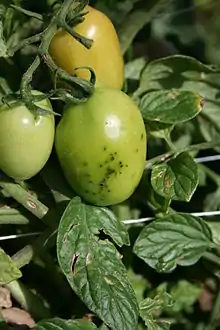Pseudomonas tomato
'Pseudomonas tomato' is a Gram-negative plant pathogenic bacterium that infects a variety of plants. It was once considered a pathovar of Pseudomonas syringae, but following DNA-relatedness studies, it was recognized as a separate species and several other former P. syringae pathovars were incorporated into it.[1] Since no official name has yet been given, it is referred to by the epithet 'Pseudomonas tomato' .[2]
| 'Pseudomonas tomato' | |
|---|---|
 | |
| Scientific classification | |
| Kingdom: | |
| Phylum: | |
| Class: | |
| Order: | |
| Family: | |
| Genus: | |
| Species: | 'P. tomato' |
| Binomial name | |
| 'Pseudomonas tomato' Gardan, et al. 1999 | |
| Type strain | |
| CFBP 2212 | |
| Pathovars | |
|
'P. t.' pv. antirrhini | |
Pathovars
- 'Pseudomonas tomato' pv. antirrhini attacks snapdragons (Antirrhinum majus).
- 'Pseudomonas tomato' pv. apii attacks celery (Apium graveolens).
- 'Pseudomonas tomato' pv. berberidis attacks Berberis species.
- 'Pseudomonas tomato' pv. delphinii attacks Delphinium species.
- 'Pseudomonas tomato' pv. lachrymans attacks cucumbers (Cucumis sativus).
- 'Pseudomonas tomato' pv. maculicola attacks members of Brassica and Raphanus.
- 'Pseudomonas tomato' pv. morsprunorum attacks plums (Prunus domestica).
- 'Pseudomonas tomato' pv. passiflorae attacks passion fruit (Passiflora edulis).
- 'Pseudomonas tomato' pv. persicae attacks the plum relative Prunus persica.
- 'Pseudomonas tomato' pv. philadelphi attacks the sweet mock-orange (Philadelphus coronarius).
- 'Pseudomonas tomato' pv. primulae attacks Primula species.
- 'Pseudomonas tomato' pv. ribicola attacks the golden currant Ribes aureum.
- 'Pseudomonas tomato' pv. tomato attacks the tomato (Lycopersicon esculentum) causing it to fruit less.[3]
- 'Pseudomonas tomato' pv. viburni attacks Viburnum species.
See also
References
- Gardan; et al. (Apr 1999). "DNA relatedness among the pathovars of Pseudomonas syringae and description of Pseudomonas tremae sp. nov. and Pseudomonas cannabina sp. nov. (ex Sutic and Dowson 1959)". Int J Syst Bacteriol. 49 (2): 469–78. doi:10.1099/00207713-49-2-469. PMID 10319466.
- Elasri; et al. (Mar 2001). "Acyl-Homoserine Lactone Production Is More Common among Plant-Associated Pseudomonas spp. than among Soilborne Pseudomonas spp". Appl Environ Microbiol. 67 (3): 1198–209. doi:10.1128/AEM.67.3.1198-1209.2001. PMC 92714. PMID 11229911.
- Virginia Tech (2011). Research team unravels tomato pathogen's tricks of the trade. http://www.vtnews.vt.edu/articles/2011/11/110311-fralin-tomatopathogen.html